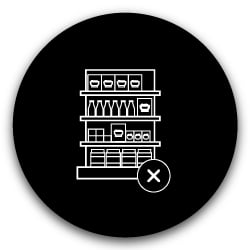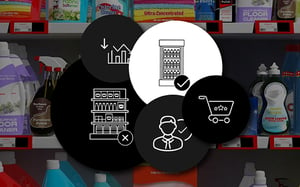No matter if you know it as blocking, zoning, fronting or straightening, facing is a critical tool that can have a direct impact on your retail success. After all, you can use it to influence the look and feel of your store. What’s more, getting it right can help you either make an additional sale or even win a new customer.
It is that powerful a tool. Of course, when referring to ‘facing’, it is also worth mentioning that there are two ways of approaching it. You can consider facings as both a noun and a verb.
As a noun, it refers to “the orientation and number of products placed on the shelf”. Meanwhile, as a verb, it refers to the “physical action of moving products to the edge of the shelf”. We touch on both instances below, detailing exactly why you need to pay attention to your retail facings.

By paying attention, you can create a better shopping experience
When customers enter your store, they’ll generally have an idea of what they want to buy. If they’ve been to your store before, they’ll also expect to find products without fuss or frustration.
For example, shoppers might know from past experiences that you stock your sweet and savoury spreads together with your teas and coffees on a shelf beside your in-house bakery, which is also positioned nearby your meat section.
Knowing they can get a sizeable chunk of their shopping done in one area instead of having to walk your entire store, makes for a pleasant shopping experience. You meet their expectations each time they shop your store.
As for how your retail facings come into play to create a better shopping experience, that’s simple. By always ensuring that there is enough stock on the shelf and you've positioned your products where customers expect them, you’re making your store more accessible. It’s a point alluded to in this article, which states that facing is “the act of getting a retail store ready for customers”.
The last thing your customers would want when they enter your store is to find a partially empty shelf or products in places where they least expect. We’ll touch on both points and their impact on your success later on in this piece.
Suffice to say; shopping can be stressful enough without making such mistakes. What’s more, in such instances, customers could believe you don’t have a product in stock even when you do.
By paying attention to your retail facings, and keeping your customers in mind when presenting your products on the shelf, you’ll create a shopper environment that they will want to return to again and again.

By not paying attention, your store can appear disorganised and messy
Alongside the need to create a better shopping experience for your customers is the point that you need to have firm control of the look and feel of your store. You could argue that you can’t have the one without the other.
If you want to offer a pleasant shopping experience, your store cannot be disorganised or messy.
However, that is precisely the scenario you can face if you ignore your retail facings.
How?
Let’s say that you’ve recently experienced the morning rush hour. Shoppers have come, purchased what they needed and have left your store in a mess. They have placed unwanted items in random places across your store, or a once organised shelf is now partially empty. If you don’t attempt to fix these issues as they happen, you could very likely develop a reputation.
Such a reputation could be along the lines of shoppers who say ‘Don’t shop that store after 10 am’, for example, because you’ll never find anything. Or, ‘That store is always messy and it’s not worth shopping there’.
Of course, there are arguments that facing is generally done near closing time when there are fewer customers. However, that shouldn’t stop you from attempting to do it throughout the day. In truth, you should fix your shelves as often as is needed. After all, your reputation is on the line.
If shoppers take one look at the empty shelves (or displays) in your store, they’re unlikely to want to shop your store but go elsewhere. That’s why it’s always a good idea to experience your store as a customer, so you can pinpoint any errors to fix.

By paying attention, it allows you to create a store that’s shoppers want to visit
As we mentioned in the first section of this article, as much as facing can refer to the space and shelf location you give to a product, it is also a physical action.
In the context of a physical activity, it involves moving products to the edge of the shelf to ensure your shelves always appear full, even if they are not. The goal here is to ensure your store shelves look neat and tidy at all times.
More importantly, it’s to create and maintain a clean-looking store that not only invites customers in but encourages them to stay and shop.
Improve your in-store experiences by developing assortments that are localised to shoppers
Let’s say, for example, that Retailer A selling FMCG goods has a wide array of products but no set merchandising structure. They may have underlying principles that they follow, but there is no organisation on the shelf. Meanwhile, Retailer B, also selling FMCG goods, has paid attention to its retail facings. That means no empty gaps and a clean-looking shelf full of merchandise.
Which store would you prefer to visit? It’s fairly obvious which store you’d prefer. Besides the fact that each store can meet the product needs of the customer, Retailer B has created a retail environment where a customer would want to shop.
It also fits into the first point we made around customer experience as well as the second point around disorganisation - by paying attention to your facings, you provide customers with a better overall experience.

By not paying attention, there is a direct impact on your sales and profit
If the above point focused on the physical activity, it’s important also to consider the second meaning where facings refer to the amount of space given to a product.
Because your shelf space is one of your most valuable assets in-store, the last thing you’d want to do is misuse it, even if only by mistake.
That leads to multiple consequences.
Firstly, by giving the wrong product too may facings, you’re losing out on sales as your higher-selling products don’t have enough shelf space. It could even result in negative growth for your category, which has a knock-on effect on the rest of your store.
Secondly, too many facings for a product that isn’t selling means you’d left with stock that you can’t sell. Again, there is a direct hit on your sales and profit. Add to that the point that this deadstock prevents you from stocking products that will sell, thereby increasing the negative impact of ignoring it.
So how do you ensure that your products receive the right amount of facings? That comes down to understanding your data. It’s important that you routinely check your record of sales per cubic metre for each gondola. Doing so allows you to make any adjustments as soon as possible maximise your sales potential.
It’s also worth referring to our previous article on product facings again as it touches on the different reasons why you’d give a product a specific amount of space on your shelf. In brief, reasons include Days of Supply (DOS), sales and weekly movement, and whether or not the product is a house brand.
Conclusion
Did you know? Retailers and suppliers like yourself use data-driven space planning software to help them improve their return on shelf space. Learn more about our different software packages, each tailored to your specific need and budget here.


